Mario is Missing!: Difference between revisions
Time Turner (talk | contribs) (→Mistakes and errors: I'm really not wording this neatly, but I hope I'm getting across what Ii mean) |
Time Turner (talk | contribs) mNo edit summary |
||
| Line 256: | Line 256: | ||
;[[Moscow]] | ;[[Moscow]] | ||
*The image for the [[Moscow Metro M]] depicts its neon as an unconnected line, the sign in actually is a connected outline of the M<ref>Shcherbakov, Mikhail (Vokabre). "Marksistskaya Station Entry, Moscow Metro Sign (Вход На Станцию Марксистская, Знак Московского Метро) (5062480611).Jpg." ''Wikimedia Commons'', Wikimedia Foundation, commons.wikimedia.org/wiki/File:Marksistskaya_station_entry,_Moscow_Metro_sign_(%D0%92%D1%85%D0%BE%D0%B4_%D0%BD%D0%B0_%D1%81%D1%82%D0%B0%D0%BD%D1%86%D0%B8%D1%8E_%D0%9C%D0%B0%D1%80%D0%BA%D1%81%D0%B8%D1%81%D1%82%D1%81%D0%BA%D0%B0%D1%8F,_%D0%B7%D0%BD%D0%B0%D0%BA_%D0%9C%D0%BE%D1%81%D0%BA%D0%BE%D0%B2%D1%81%D0%BA%D0%BE%D0%B3%D0%BE_%D0%9C%D0%B5%D1%82%D1%80%D0%BE)_(5062480611).jpg. Retrieved January | *The image for the [[Moscow Metro M]] depicts its neon as an unconnected line, the sign in actually is a connected outline of the M<ref>Shcherbakov, Mikhail (Vokabre). "Marksistskaya Station Entry, Moscow Metro Sign (Вход На Станцию Марксистская, Знак Московского Метро) (5062480611).Jpg." ''Wikimedia Commons'', Wikimedia Foundation, commons.wikimedia.org/wiki/File:Marksistskaya_station_entry,_Moscow_Metro_sign_(%D0%92%D1%85%D0%BE%D0%B4_%D0%BD%D0%B0_%D1%81%D1%82%D0%B0%D0%BD%D1%86%D0%B8%D1%8E_%D0%9C%D0%B0%D1%80%D0%BA%D1%81%D0%B8%D1%81%D1%82%D1%81%D0%BA%D0%B0%D1%8F,_%D0%B7%D0%BD%D0%B0%D0%BA_%D0%9C%D0%BE%D1%81%D0%BA%D0%BE%D0%B2%D1%81%D0%BA%D0%BE%D0%B3%D0%BE_%D0%9C%D0%B5%D1%82%D1%80%D0%BE)_(5062480611).jpg. Retrieved January 30, 2018.</ref>. | ||
;[[New York]] | ;[[New York]] | ||
Revision as of 16:44, January 30, 2018
Template:Infobox Mario is Missing! is an educational game created for MS-DOS, the SNES, and the NES. The gameplay was widely panned by critics, although its Super Mario World music remixes have gained recognition. Mario is Missing! was released in floppy disk format for MS-DOS in 1992, with the CD-ROM Deluxe edition and console versions released the following year. A follow-up called Mario's Time Machine was eventually produced. This is the first game where Luigi is the main protagonist with Mario in a supporting role and it was the only solo adventure for Luigi until 2001 when Luigi's Mansion was released on the Nintendo GameCube.
Story
Bowser decides to flood the Earth using hairdryers from Hafta Havit Mail-Order to melt Antarctica. In order to buy the hairdryers, Bowser has his Koopa Troopas travel all over the world and steal various important landmarks that he plans to sell.
Mario, Luigi and Yoshi follow Bowser to Antarctica to stop him, but when Mario goes on ahead he is captured by Bowser. The PC version is the most elaborate: Luigi is too scared to go inside the castle, so Mario enters alone. Despite Luigi's warnings against taking candy from strangers, Mario eats some candy offered to him by Bowser (disguised as a butler), and is then scooped up in a net. In the SNES version, Mario arrives last in Antarctica (Luigi and Yoshi are already present, and Mario had apparently warped to Antarctica by accident while he was distracted by the incomplete title in Dinosaur Land), and Luigi even seemed eager to go into the castle after appreciating that Mario "dropped in." with a pit opening up beneath him when the group reaches the castle, while in the NES version, a Koopa throws a bag over Mario while the latter is fuming about the title claiming he was missing as he walks through the snow and ice.
With Mario captured, the task of returning all the stolen artifacts and saving both his brother and Earth falls to Luigi, who bravely enters the castle, leaving Yoshi outside.
Story from console instruction booklet
Bowser's Plot
Oh no! Bowser and his bad boys are back to a life of crime. This time, it's not Mario World — it's your world! From his Antarctic castle, Bowser hustles his cold-blooded crew of cantankerous Koopas into his powerful Passcode Operated Remote Transport And Larceny System (PORTALS). The twisted turtles transport themselves throughout the globe, where celebrated cities suffer shell-shocking crime waves, as turtles trash landmarks and loot ancient artifacts. With dough from his slimy scales, Bowser hoards hair dryers from the Hafta-Havit Hotline. His plot? Melt Antarctica and flood the planet! Whoa!
Mario's Fate
Will the brave brothers from Brooklyn permit this abominable snow plan? The boys say "Not!" Mario, Luigi and Yoshi trek across ice and snow to shellac the shelled ones' schemes. But Bowser's slick; in one last trick, he takes the dearest thing of all...Mario is Missing!
Luigi's Mission
Luigi must stop the Koopas, foil Bowser's plan, and find Mario. Sneaking into each Portal, Luigi is transported to a city in trouble. There, Luigi needs to nab each Koopa, grab its loot, and return the artifact to its proper landmark. Along the way, Luigi explores the city, chats with the locals, reads maps, and solves puzzles. Help him do this before time runs out! Once he figures out where he is on the globe,
Luigi must use the Globulator to call Yoshi. Only after Yoshi scares Pokey away, can Luigi return to Bowser's castle and lock the Portal for that city.
Ending
In the DOS version, Luigi takes Bowser's shell (which covers his tail in this depiction) off, causing Bowser to run off screen, embarrassed about his polka-dot boxers. This is the only time Bowser's been seen in his Beach Koopa form. Luigi shakes the shell to retrieve the key to Mario's cell, and then throws the carapace away. Bowser returns wondering where his shell is, Luigi then lies to him saying he threw the shell off the balcony; then, when Bowser leans over the railing to look for it, Luigi kicks him off and he lands in the snow. Luigi then opens Mario's cell and the two dance around in joy. They then go outside and shake Yoshi's hand, before walking off into the distance together. Bowser then pokes his head out of the snow, looking in their direction with his shell back on.
In the Macintosh version, Bowser doesn't run off after his boxers are revealed, and Luigi smacks him off the balcony with his own shell.
In the SNES version of the ending, Luigi pulls a lever to reveal Mario behind a wall. Bowser then jumps down from a distant ledge, but Luigi pulls the same lever, causing Bowser to fall down into a cannon. He is then launched out of the castle and into the snow, where he freezes instantly and then shatters. In the NES version, Luigi and Bowser have a boss battle and "Bowser" turns out to be a normal Koopa Troopa in disguise, who turns the key to Mario's cell, freeing him.
Characters
- Luigi
- Mario
- Yoshi
- Bowser
- Koopa Troopa
- Pokey (PC and SNES)
- Larry Koopa (PC)
- Roy Koopa (PC and SNES)
- Wendy Koopa (PC)
- Iggy Koopa (PC and SNES)
- Ludwig von Koopa (PC and SNES)
- Princess Peach (CD-ROM Deluxe only)
- Toad (CD-ROM Deluxe only)
- Donkey Kong (CD-ROM Deluxe only)
- Monty Mole (CD-ROM Deluxe only)
- Dino Rhino (CD-ROM Deluxe only)
Gameplay
In each level, Luigi must retrieve several artifacts which were stolen by several Koopa Troopas within the city and return them to their rightful places. Luigi must jump on the Koopa Troopas to defeat them and reclaim the artifacts, which he then takes back to the landmarks they were stolen from. He must answer trivia questions about the landmarks before the curators will take the wares back. In the SNES version, all the information kiosks are manned by women resembling Princess Daisy (complete with crown), although this is an unconfirmed appearance.
The DOS version adds a videophone aspect to gameplay, and Luigi must call the help number provided at the landmarks to get in touch with his friends, answer the questions, return the artifact, and receive a monetary reward. The mayor of the city also phones Luigi when he arrives, asking for his help in stopping the Koopas; he later phones when Luigi secures the city, thanking him and wishing him luck in finding Mario. The red plumber himself even manages to phone Luigi, giving him advice on his journey as well as updates on his capture and the Koopas' struggle to maintain their plot as planned. The DOS version also has a Taxi feature, in which Luigi collects little Taxi tokens around the city and then exchanges them for rides across town. The SNES version instead uses more Warp Pipes to facilitate speedy travel.
As well as returning the artifacts, Luigi must also deduce what city he's in so that he can use the Globulator and call Yoshi to his aid for double the walking and running speed. Without Yoshi, Luigi cannot finish the level, as the exit pipe is occupied by a large Pokey. Yoshi proceeds to gobble the Pokey up in the DOS version, whereas the Pokey is merely scared away by Yoshi's presence in the SNES release.
Once Luigi has secured all the cities whose doors are located on a floor of the castle, Luigi must use a Fire Flower collected in the cities to defeat them using their only weakness - Fire. The console releases remove the Fire Flower in favor of a small boss battle. However, the bosses cannot hurt Luigi, and must be stomped on a certain number of times to be defeated in the SNES and NES versions. The console versions also differ in that the Koopa Troopas are not defeated when they are knocked about and forced to leave in an undignified manner, but rather a sound stomp with destroy them upon impact (including the shell). The SNES version also has them literally fall to pieces, like a collapsing building.
In addition, there was a later enhanced edition for PC known as the CD-ROM Deluxe version. It included full-on voice acting to go along with the dialogue, although not all of the in-game text matched the audio exactly. The voice actors are known (Kathy Fitzgerald, Rob Wallace, Bob Sorenson, Nicholas Glaeser, David Gill), but the game does not specify which of them supplied which voices. There are also some graphical changes, such as loading screens when the screen is black, and icons of Princess Toadstool, Toad and Donkey Kong replace a recurring phone call NPC (although the old dialogue was not changed on-screen). The viewings of every historic spot in particular were originally recreated and shown in garish coloring. The CD-ROM Deluxe version replaces most of these pictures with realistic photographs and even live-action video clips to represent the landmarks, with some exceptions carried over from the floppy disk version.
Cities
MS-DOS
- First Floor
- Rome, Italy (Europe) 1st door
- Nairobi, Kenya (Africa) 2nd door
- Beijing, China (Asia) 3rd door
- Moscow, Russia (Europe) 4th door
- San Francisco, United States (North America) 5th door
- Second Floor
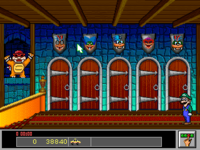
- Athens, Greece (Europe) 1st door
- Madrid, Spain (Europe) 2nd door
- Marrakech, Morocco (Africa) 3rd door
- Mexico City, Mexico (North America) 4th door
- Paris, France (Europe) 5th door
- Third Floor
- Berlin, Germany (Europe) 1st door
- Buenos Aires, Argentina (South America) 2nd door
- Dublin, Ireland (Europe) 3rd door
- Kathmandu, Nepal (Asia) 4th door
- Sydney, Australia (Oceania) 5th door
- Fourth Floor
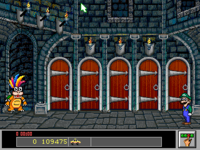
- Amsterdam, Netherlands (Europe) 1st door
- Bombay, India (Asia) 2nd door
- Cairo, Egypt (Africa) 3rd door
- Tokyo, Japan (Asia) 4th door
- Toronto, Canada (North America) 5th door
- Fifth Floor
- Istanbul, Turkey (Europe) 1st door
- Jerusalem, Israel (Asia) 2nd door
- London, United Kingdom (Europe) 3rd door
- New York City, United States (North America) 4th door
- Rio de Janeiro, Brazil (South America) 5th door
SNES version
- First floor
- San Francisco, California, USA (North America)
- Moscow, Russia (Europe)
- Nairobi, Kenya (Africa)
- Beijing, China (Asia)
- Rome, Italy (Europe)
- Second floor
- Paris, France (Europe)
- Mexico City, Mexico (North America)
- Sydney, Australia (Oceania)
- Buenos Aires, Argentina (South America)
- Athens, Greece (Europe)
- Third floor
- London, United Kingdom (Europe)
- Cairo, Egypt (Africa)
- Tokyo, Japan (Asia)
- Rio de Janeiro, Brazil (South America)
- New York City, New York, USA (North America)
NES version
- First room
- New York City, New York (United States)
- Rome, Italy
- Second room
- Sydney, Australia
- San Francisco, California (United States)
- Third room
- Fourth room
- Fifth room
- London, England
- Buenos Aires, Argentina
- Sixth room
- Mexico City, Mexico
- Cairo, Egypt
- Seventh room;
Mistakes and errors
This section is under construction. Therefore, please excuse its informal appearance while it is being worked on. We hope to have it completed as soon as possible. This section is currently under construction by Time Turner (talk).
Although Mario is Missing! is intended to teach its players geographical facts, it contains numerous errors in its teaching material.
- Several cities that share its name with its surrounding country or state do not have "City" in their name; for example, New York City is simply "New York", Guatemala City is "Guatemala", and so on.
- Diacritics are also not rendered; San José is "San Jose", for example, and Medellín is "Medellin".
- The Deluxe version released in 1993 reuses the map of the DOS version in 1992, meaning that it lists several countries that no longer exist, including Czechoslovakia (which dissolved into the Czech Republic and Slovakia) and Yugoslavia (which dissolved into Bosnia and Herzegovina, Croatia, Macedonia, Montenegro, Serbia, and Slovenia). It also does not list Eritrea, which split from Ethiopia.
- However, countries such as Croatia, Macedonia, and Eritrea gained independence in 1991.
- All other mistakes between the DOS and Deluxe versions are also identical.
- No cities are listed for Armenia or Brunei.
- The capital of Greenland is spelled "Nuk" and not Nuuk.
- El Salvador's name is given as "San Salvador", which is the name of its capital.
- Colombia's capital, Bogotá is misspelled as "Bogata".
- The capital of Venezuela, Caracas, is misspelled as "Caracus".
- Suriname is spelled "Surinam" (although this is the country's old name, "Suriname" is the preferred spelling [1]).
- French Guiana is rendered with a hyphen, as "French-Guiana".
- The capital of Paraguay, Asunción, is spelled "Asucion".
- The city of Bahía Blanca in Argentina is spelled "Bahai Blanca".
- Iceland's capital, Reykjavik, is spelled "Reykavik".
- The capital of Sweden, Stockholm, is spelled "Stolkolm".
- The second-largest city in Bulgaria, Plovdiv, is spelled "Ploudiv".
- Monte Carlo is listed as a city in Monaco, despite being an administrative region.
- Western Sahara is listed as a country despite the still-disputed nature of its sovereignty.
- The city of Smara in Western Sahara is spelled "Semara".
- Kufra is listed as a city in Libya despite being an oasis; its name is even rendered as "Kufra Oasis".
- N'Djamena is rendered with a space, as "N' Djamena".
- El-Obeid is rendered without a hyphen, as "El Obeid".
- The city of Mombasa in Kenya is spelled "Monbassa".
- Lesotho is rendered as "Sinai Lesotho".
- Saudi Arabia's capital, Riyadh, is spelled "Riyad".
- Muttrah is not only listed as a city in Oman, despite being an administrative district, it is also misspelled as "Matrah".
- The capital of Kuwait, Kuwait City, is rendered as "Al Kuwait".
- The city of Tel Aviv in Israel is rendered as "Tel Aviv-Jaffa".
- The city of Ashgabat was spelled "Ashkhabad" before 1991; "Ashkhabad" is the name used in-game.
- The city of Almaty was renamed from "Alma-Ata" after Kazakhstan gained independence (although "Alma-Ata" is a transliteration of the original Russian name); "Alma-Ata" is also the name used in-game.
- Tajikistan's capital, Dushanbe, is spelled "Dashnabe".
- The capital of Mongolia, Ulaanbaatar, is spelled "Ulaabaatar"
- The capital of North Korea, Pyongyang (alternate spelling P'yŏngyang), is rendered as "P'yong'yang".
- Bhutan's capital, Thimphu, is spelled "Thimpu".
- Myanmar is rendered as "MyAnmar".
- Yangon in Myanmar was renamed from "Rangoon" in 1989[2], but the game still uses "Rangoon".
- The city of Kota Kinabalu in Malaysia is spelled "Kota Kinabatu".
- The largest city in New Zealand, Auckland, is spelled "Auchland".
- The Little America exploration base in Antarctica is listed as a city.
- A tourist uses the name "Latin Manhattan" for Rome. This has never been a nickname for the city; in fact, it is an alcoholic drink[3]. However, the nickname has been associated with Buenos Aires[4].
- The Colosseum's pamphlet lists its circumference as 524 meters, and not 544 meters as in reality[5].
- The Michelangelo's Paintbrush item is touted as if it was his sole painting tool; there is no evidence that Michelangelo used a single paintbrush for the entirety of the Sistine Chapel, nor is there a paintbrush that is particularly famous for being used by him.
- A scientist says that "Sistine" means six in Latin. Six in Latin is "sex" or "sextus"; "Sistine" refers to any of the Sixtus popes, although "Sixtus" is derived from "sextus"[6].
- The Sistine Chapel's pamphlet describes Michelangelo painting the Sistine Chapel ceiling's 900 square meters. He actually painted around 534 square meters[7].
- It also describes him as having painted while lying down, which is incorrect. He painted while standing up.[8]
- The Trevi Fountain's pamphlet says that anyone who throws a coin over their shoulder and into the fountain is guaranteed to return to Rome. Although technically correct, this is missing details, as the myth specifies that a person must throw a coin with their right hand over their left shoulder[9].
- The Trevi is also said to be the oldest fountain in Rome, which is incorrect due to the Fountain in Piazza Santa Maria in Trastevere.
- The Pantheon is stated to have eight columns when it actually has sixteen[10].
- Its pamphlet also says that it was made out of brick and marble, completely ignoring how the Pantheon was largely constructed with concrete[11].
- The pamphlet for the Spanish Steps says that it was paid with "French" money, this is incorrect. The money was left by French diplomat Étienne Gueffier in his will, but it was in scudi, a depreciated Italian coin[12].
- It also says that the Spanish embassy that lent its name to the stairs was an embassy for "the Vatican"; it is an embassy to the Holy See, which is distinct from Vatican City[13].
- Also, the Spanish Steps only have 135 steps[14], and not 328 as the game claims.
- Many of the buildings in Nairobi are old and dilapidated, with some even being held up with sticks and straw roofs; this is a far cry from the contemporary city in reality.
- A tourist said that he had to fight off lions and elephants when travelling from Mombasa to Nairobi, which is odd given that there is a highway that directly connects the two cities.
- A scientist comments that female Asian elephants cannot grow tusks, which is incorrect. Some of them have smaller tusks, called "tushes", that are notably more brittle than males' tusks, but are still present. The scientist also implies that male Asian elephants always grow tusks, which is also incorrect.[15]
- The pamphlet for the Nairobi National Park describes the area as "undisturbed", which is incorrect given the proximity of human civilization and how it interferes with the area[16].
- The Maasai Headdress, in both its NES and SNES sprites, look nothing like the enkuraru headdresses worn by actual Maasai warriors[17][18].
- The pamphlet for the Maasai village says that Africa has "more than 70 tribes", which is a gross understatement: estimates often place more than 3,000 tribes in Africa[19][20].
- The pamphlet also says that new warriors are initiated as soon as they turn fifteen, but this process can begin anywhere from the ages of fourteen to eighteen[21]
- The National Museum of Kenya's actual name is the Nairobi National Museum[22].
- The Human Skull was discovered by Bernard Ngeneo, a member of Richard Leakey's expedition team, and not Leakey himself[23].
- Also, unlike what the game claims, the skull depicts a member of the Homo rudolfensis species and not Homo habilis (although initial claims thought the skull to be Homo habilis, it was first classified as a new species in 1986[24]).
- The revolving restaurant at the top of the Kenyatta International Conference Center shut down in the 1980's,[25] and yet it is still depicted as being operational in-game.
- A scientist says that construction on the center finished in 1970, when it was actually in 1973[26].
- Also, the building is 28 storeys tall, and not 27 as the pamphlet says[26].
- The center is also describes as being a "United Nations headquarters". Although the fourth United Nations Conference on Trade and Development did take place at the center, this was only for the purposes of the assembly; the building was never used as a headquarters[27][28].
- The pamphlet for the center describes Jomo Kenyatta solely as a "freedom fighter". For starters, although he rallied for Kenya to be freed from British rule, he did so through non-violent means and actively opposed others' brutal methods[29] (labelling him as a "freedom fighter" due to his desire for an independent Kenya is a misuse of the term, anyways). Beyond that, he is best known as the first Prime Minister and President of Kenya, and not as a "freedom fighter".
- A boy states that China is the largest country in Asia, even though Russia has the most territory (without even including its territory in Europe)[30]
- A business woman states that Beijing has been the capital of China for 800 years. However, the timeline does not work out: considering that Beijing was officially made the capital in 1279[31], just above 700 years would have passed by the time of Mario is Missing!'s release. This also ignores the two gaps in which Beijing was not China's capital: from 1368 to 1420, when Nanjing was made the capital during the Ming dynasty,[32] and from 1928 to 1949, after the 1928 Chinese reunification and numerous other events until the formation of the People's Republic of China.
- A police officer claims that they are standing on Chang An Avenue. While this makes sense in the SNES version, where every NPC is restricted to one street, the NPCs in the PC versions move around, and the police officer can therefore tell Luigi this on multiple streets.
- A boy says that the Gate of Heavenly Peace leads to the Emperor's home in the Forbidden City, which is misleading: the Forbidden City itself was the Emperor's home.
- A scientist says that the gate was created in the fourth century, while the Forbidden City's pamphlet says that it was built in 1651. Both of these are incorrect: the gate was built in 1417[33], although it was rebuilt in 1651 after being burned down[34].
- The scientist also says that the reigning emperor, the Yongle Emperor, was the one who built the gate. While he ordered its construction, it was designed by Kuai Xiang in conjunction with other architects[35]
- It is stated on several occasions that only the Emperor could pass through the Gate of Heavenly Peace, when it was actually the Gate of China that had this restriction[33].
- It is stated on multiple occasions that the Great Wall of China is the only man-made object that is visible from space, despite this being completely false; other objects are visible from space[36][37] and the wall itself is not even visible[38][39].
- The pamphlet states that the Great Wall is one of "the world's seven great wonders", which is misleading: the traditional list of the seven Wonders of the World does not include the Great Wall, but it is typically included in lists about the wonders of the medieval world[40][41].
- The pamphlet also says that it took 300,000 men ten years to construct the entire Great Wall. This is incorrect for three reasons: for one, portions of the wall were built across several centuries; secondly, several hundreds of thousands[42], if not millions[43], of people were forced to work on the wall; finally, while 300,000 soldiers were conscripted to build one section of the wall, it took them nine years to do so[44].
- It also states that the wall was "[b]egun in fifth century BC", despite walls being constructed many centuries prior; they were also only joined together after 221 BC[45][better source needed]
- Tian An Men Square is claimed to be the largest public square in the world, despite the existence of other squares like Merdeka Square in Jakarta.
- The dialogue makes it clear that the stolen Monument to the People's Heroes refers to the obelisk, but its image depicts a statue outside of the Mausoleum of Mao Zedong (this statue is also what is shown in Luigi's photo of Tian An Men Square).
- It is stated that the monument is made only out of granite, without referencing how it is also made out of marble[46].
- The pamphlet for the square says that it was expanded in 1949, when it was expanded several times starting from the 1950s, most prominently in 1959 when it was expanded to 99 acres (and not 98)[47]
- The building that is stolen from the Temple of Heaven is called the Hall of Good Harvest, the Good Harvest Hall, and the Great Hall in-game, none of which are actually names for it. It is officially the "Hall of Prayer for Good Harvests"[48].
- One of the questions for returning the hall involves answering what was not used during its construction; though "air condition" is a valid answer, it is not accepted for the question.
- The image for the Moscow Metro M depicts its neon as an unconnected line, the sign in actually is a connected outline of the M[49].
- King Kong is stolen from the Empire State Building and must be returned to its supposed rightful place, despite King Kong being entirely fictional.
Gallery
- For this subject's image gallery, see Gallery:Mario is Missing!
- Ss mim-pc t.png
PC title screen
- Ss mim-snes title.png
SNES title screen
- Ss mim-nes t.png
NES title screen
Mario meeting Luigi in the PC version (scene by Dan Guerra[50])
Media
- For a complete list of media for this subject, see List of Mario is Missing! media.
Quotes
- Main article: List of Mario is Missing! quotes
Pre-release and unused content
Unused data
Dialogue intended for the ending of the game is in the CD-ROM Deluxe edition of the game: Game ending reconstructed with voices.
It also appears that Lemmy and Morton were going to appear in game, as their unused dialogue was found in the Deluxe version's data (they are the only Koopalings who do not appear in at least one version of the game)[51]. In the final game, Lemmy is mentioned as having run off to play in the snow while Morton is said to watch the others. Furthermore, the CD-ROM release of the game features Lemmy on the cover despite him not appearing in the game.[52]
The Deluxe edition's files also contain live-action footage featuring landmarks of several cities that are not visited in-game. These include:
- Wat Phra Kaew, the Chao Phraya River, and Wat Pho in Bangkok, Thailand;
- Taft Avenue, the Intramuros, Rizal Park, and the Malacañang Palace in Manila, Philippines;
- Hotel Gellért, the Széchenyi Chain Bridge, the Fisherman's Bastion, and the Hero's Square in Budapest, Hungary;
- Mount Royal, the Olympic Stadium, Saint Joseph's Oratory, and the Notre-Dame Basilica in Montreal, Canada (although the city is featured in the game's NES release);
- Victoria Peak, the Tiger Balm Garden, the The Excelsior, and the HSBC Building in Hong Kong, China;
- The Sunda Kelapa port and the National Monument in Jakarta, Indonesia;
- The White House, the Washington Monument, the Lincoln Memorial, and the United States Supreme Court Building in Washington, D.C., United States of America;
- The Government Palace and the Plaza Mayor in Lima, Peru;
- Al-Kāẓimiyyah and the Tigris river in Baghdad, Iraq;
- Suomenlinna, Helsinki Central Station, Temppeliaukio Church, and the Sibelius Monument in Helsinki, Finland;
Interestingly, there are ten cities that go unused; considering the unused dialogue for Lemmy and Morton, it is possible that they were meant to guard five of the cities each (considering how every other Koopaling guards five cities of their own).
There are also unused voice clips that also reference locations that are not in-game, including those that do not even have footage. Beyond the previously mentioned landmarks, these include: the Lacqueur Pavilion in Bangkok; the Bogor Botanical Gardens and the National Museum of Indonesia in Jakarta; the Cathedral of Lima in Lima; and the Archway of Ctesiphon near Baghdad. Oddly enough, the Notre-Dame Basilica in Montreal is the only landmark to have a video clip and not a corresponding audio clip. Also, the White House and the Supreme Court are the only ones to have unique messages: "We are attempting to achieve world peace and are unable to take your call," and "We are hearing an important case and are unable to take your call," respectively.
Reception
Sales
In an August 1993 press release, Software Toolworks claimed that sales of the console versions of Mario is Missing! exceeded $7,000,000 for the fiscal quarter and that the game boosted the company's revenue during a slow quarter[53]. One employee also claims that the game sold over one million units.[54]
Legacy
Luigi's sprite in the PC version started the Internet meme "Weegee", as well as Mario being "Malleo" and Yoshi being called "Yushee".
References to other games
- Super Mario Bros. - The Koopa Troopas look similar to their Super Mario Bros. artwork in the MS-DOS version.
- Super Mario World - The Mario, Luigi and Yoshi sprites in the NES and SNES versions were taken from this game. Bowser's sprite in the NES version appears to use an edited version of Morton, Ludwig, and Roy's body from this game, along with an edited version of Lemmy's head. As such, he is uncharacteristically short in this game. When retracted into his shell, it uses the normal Koopa Troopa shell sprite from this game, except with all original detail removed and spikes drawn on. Finally, after defeat, he is knocked out of his shell and appears as a Beach Koopa, specifically from a Koopa Troopa.
Staff
- Main article: List of Mario is Missing! staff
Names in other languages
| Language | Name | Meaning |
|---|
Trivia
- According to the MS-DOS release, Mario has a fear of the dark, which he is increasingly worried that Bowser will exploit in torture. This is not seen or referenced in other games, except potentially Hotel Mario when he stutters before entering the cave hotel without a flashlight.
- Mario's voice is inconsistent in the the CD-ROM Deluxe edition. Sometimes he has an Italian accent, sometimes he has a New York accent with a slight hint of Italian. The game's data includes all of his lines in both accents, so it's likely that the developers accidentally assigned some from both. [55]
- Luigi, however, has a consistent New York accent.
- Although some Mario media supply voice acting for the Koopalings, the CD-ROM Deluxe edition is the first game to have the Koopalings voiced, as well as the only game to actually supply them with dialogue until the release of Mario & Luigi: Paper Jam. Later games starting with New Super Mario Bros. Wii have the Koopalings voiced, although it is limited to roars and grunts.
- The USA and Canada are the only countries that are visited twice at different cities in all versions of the game (New York and San Francisco in USA, Toronto and Montreal in Canada).
References
- ^ Bryson, Bill. "S." Bryson's Dictionary of Troublesome Words: A Writer's Guide to Getting It Right, Doubleday Canada, 2013. Google Books, books.google.ca/books?id=I-nqQ2MRylMC. Retrieved January 21, 2018.
- ^ "Myanmar Profile - Timeline." BBC News, BBC, 11 Jan. 2018, www.bbc.com/news/world-asia-pacific-12992883. Retrieved January 21, 2018.
- ^ Dietz, Frieda Meredith. "Latin Manhattan." Let's Talk Turkey: Adventures and Recipes of the White Turkey Inn, Dietz Press, 1948, p. 79. Google Books, books.google.ca/books?id=2zVKAAAAMAAJ. Retrieved January 21, 2018.
- ^ Lloyd, Harvey. "The Appeal of Buenos Aires." Voyages: The Romance of Cruising, Dorling Kindersley, 1999, p. 115. Archive.org, archive.org/details/voyagesromanceof00harv. Retrieved January 21, 2018.
- ^ Ruhl, Marcus. "Ancient Roman Colosseum in Rome." Ancient Roman Colosseum: History, Architecture, Purpose, 2013, www.romanlife-romeitaly.com/ancient-roman-colosseum.html. Retrieved January 21, 2018.
- ^ Harper, Douglas. "Sistine (Adj.)." Online Etymology Dictionary, www.etymonline.com/word/sistine. Retrieved January 21, 2018.
- ^ Bambach, Carmen C. "A New Artistic Vision." Michelangelo: Divine Draftsman and Designer, Metropolitan Museum of Art, 2017, p. 83. Google Books, books.google.ca/books?id=3zQ7DwAAQBAJ. Retrieved January 21, 2018.
- ^ "Michelangelo Didn't Lie Down on the Job." The New York Times, 22 Apr. 1989, www.nytimes.com/1989/04/23/opinion/l-michelangelo-didn-t-lie-down-on-the-job-008889.html. Retrieved January 21, 2018.
- ^ "Coins into the Trevi Fountain." WelcomeToRome.net, www.welcometorome.net/en/about-rome/things-not-to-miss/coins-into-the-trevi-fountain. Retrieved January 21, 2018.
- ^ "Interesting Facts About Rome's Pantheon." Rolling Rome, romeonsegway.com/10-facts-about-the-pantheon/. Retrieved January 21, 2018.
- ^ Moore, David. "The Pantheon." Romanconcrete.com, 1995, www.romanconcrete.com/docs/chapt01/chapt01.htm.
- ^ Elling, Christian. Rome: The Biography of Her Architecture from Bernini to Thorvaldsen, illustrated ed., Westview Press, 1975, p. 328. Google Books, books.google.ca/books?id=rOxPAAAAMAAJ. Retrieved January 21, 2018.
- ^ Chepkemoi, Joyce. "What Is the Difference Between the Vatican City and the Holy See?" WorldAtlas, 21 June 2017, www.worldatlas.com/articles/what-is-the-difference-between-vatican-city-and-the-holy-see.html. Retrieved January 21, 2018.
- ^ Edwards, Catherine. "Eight Things You Should Know about Rome's Spanish Steps." The Local, 23 Sept. 2016, www.thelocal.it/20160923/eight-things-you-should-know-about-romes-spanish-steps. Retrieved January 21, 2018.
- ^ "Asian elephant." Smithsonian's National Zoo, The Smithsonian, 15 Aug. 2017, nationalzoo.si.edu/animals/asian-elephant. Retrieved January 24, 2018.
- ^ Morell, Virginia. "Surrounded! - Civilization Is Encroaching on Nairobi National Park in Kenya - Nairobi's Wild Side." International Wildlife, vol. 26, no. 4, 1996. Findarticles.com, archive.org, web.archive.org/web/20050115230346/http://findarticles.com/p/articles/mi_m1170/is_n4_v26/ai_18388413. Retrieved January 24, 2018.
- ^ "Maasai Peoples - Enkuraru Headdress." Spencer Museum of Art, University of Kansas, 2016, collection.spencerart.ku.edu/eMuseumPlus?service=ExternalInterface&module=collection&objectId=35893&viewType=detailView. Retrieved January 23, 2018.
- ^ "Maasai Warrior with Red Ochre Face Paint, Kenya." Carol Beckwith & Angela Fisher, 2012, carolbeckwith-angelafisher.com/collections/painted-bodies/maasai-warrior-with-red-ochre-face-paint-kenya/. Retrieved January 24, 2018.
- ^ "African Tribe List." interesting-africa-facts.com, interesting-africa-facts.com/Africa-People/African-Tribe-List.html. Retrieved January 24, 2018.
- ^ "People of Africa." africanholocaust.net, www.africanholocaust.net/peopleofafrica.htm. Retrieved January 24, 2018.
- ^ Temps, Dietmar. "Morani - The Warriorhood Tradition of the Kenyan Tribes." dietmartemps.com, dietmartemps.com/travel-blog/morani-the-warriorhood-tradition-of-the-kenyan-tribes_669/. Retrieved January 24, 2018.
- ^ "Nairobi National Museum." National Museums of Kenya, www.museums.or.ke/introduction/. Retrieved January 22, 2018.
- ^ Leakey, R. E. F. "Evidence for an Advanced Plio-Pleistocene Hominid from East Rudolf, Kenya." Nature, vol. 242, no. 5398, 13 Apr. 1973, pp. 447–450., doi:10.1038/242447a0. Retrieved January 24, 2018.
- ^ Smithsonian's National Museum of Natural History. "Homo rudolfensis." The Smithsonian Institution's Human Origins Program, The Smithsonian, 1 Mar. 2010, humanorigins.si.edu/evidence/human-fossils/species/homo-rudolfensis.
- ^ Kamau, Macharia. "Historical KICC Hotel Back to Life." standardmedia.co.ke, The Standard, 19 Feb. 2012, 00:00, www.standardmedia.co.ke/article/2000052405/historical-kicc-hotel-back-to-life. Retrieved on January 23, 2018.
- ^ a b "administrator". “The Kenyatta International Conference Centre.” Buildesign.co.ke, 7 June 2013, buildesign.co.ke/the-kenyatta-international-conference-centre/. Retrieved January 24, 2018.
- ^ Mochorwa, Silvia. "Kenya's Mice Tourism Goes a Notch Higher." kicc.co.ke, 8 Jan. 2016, kicc.co.ke/media/newsDetails/35. Retrieved January 23, 2018.
- ^ United Nations Conference on Trade and Development, Proceedings of the United Nations Conference on Trade and Development FOURTH SESSION Nairobi (5-31 May 1976), unctad.org/en/Docs/td218vol1_en.pdf. Retrieved on January 23, 2018.
- ^ "Kenyatta, Jomo 1891(?)–1978." Contemporary Black Biography. Encyclopedia.com. 21 Jan. 2018 www.encyclopedia.com/people/history/african-history-biographies/jomo-kenyatta. Retrieved January 23, 2018.
- ^ Pariona, Amber. "Which Are the 10 Largest Asian Countries By Area?" WorldAtlas, 3 Nov. 2017, www.worldatlas.com/articles/which-are-the-10-largest-asian-countries-by-area.html.
- ^ Wang, Yi. "Dadu in the Yuan Dynasty." A Century of Change: Beijing's Urban Structure in the 20th Century, illustrated ed., Springer International Publishing, 2016, p. 14. Google Books, books.google.ca/books?id=RRq1DAAAQBAJ. Retrieved January 26, 2018.
- ^ Fang, Jun. China's Second Capital – Nanjing under the Ming, 1368-1644. Routledge, 2014. Google Books, books.google.ca/books?id=f1uhAwAAQBAJ. Retrieved January 26, 2018.
- ^ a b "People's Daily Online". "The History of Tiananmen Gate." eBeijing, 26 Nov. 2010, www.ebeijing.gov.cn/BeijingInformation/BeijingsHistory/t1141051.htm. Retrieved January 26, 2017.
- ^ "Tian'anmen -- the Gate of Heavenly Peace." China.org.cn, China Internet Information Center, www.china.org.cn/english/features/beijing/30801.htm. Retrieved January 26, 2018.
- ^ "Designer of Tiananmen." Beijing Attractions, 2010, www.beijingattractions.org/Beijing-History/Designer-of-Tiananmen.html. Retrieved January 26, 2018.
- ^ Miles, Kathy A. "Viewing Earth: How Much Can Be Seen from Space?" Starryskies.com (Archive.org), 2004, web.archive.org/web/20060212052143/http://starryskies.com/articles/2003/10/earth.visible.html. Retrieved January 24, 2018.
- ^ Sweeney, Chris. "The World's 18 Strangest Gardens." Popular Mechanics, 11 Aug. 2010, www.popularmechanics.com/home/lawn-garden/how-to/g348/worlds-18-strangest-gardens/#slide-5.
- ^ Adams, Cecil. "Is the Great Wall of China the Only Manmade Object You Can See from Space?" The Straight Dope, 31 Jan. 1986, www.straightdope.com/columns/read/417/is-the-great-wall-of-china-the-only-manmade-object-you-can-see-from-space/. Retrieved January 24, 2018.
- ^ Mikkelson, David. "Can You See the Great Wall of China from the Moon?" Snopes.com, 20 July 2014, www.snopes.com/science/greatwall.asp. Retrieved January 24, 2018.
- ^ "Seven Wonders of the Medieval World." Unmuseum.org, www.unmuseum.org/7wonders/medieval_wonders.htm.
- ^ Oberheu, Caroline. "The 7 Wonders of the Medieval World." WorldAtlas, 6 Sept. 2017, www.worldatlas.com/articles/the-7-wonders-of-the-medieval-world.html.
- ^ Slavicek, Louise Chipley. "The Human Cost of Building the First Great Wall." The Great Wall of China, Infobase Publishing, 2009, pp. 33–35. Google Books, books.google.ca/books?id=EwFYg_twIgYC. Retrieved January 26, 2018.
- ^ Evans, Thammy. "Myths." Great Wall of China: Beijing & Northern China, illustrated ed., Bradt Travel Guides, 2006, p. 11. Google Books, books.google.ca/books?id=C5w9M8n9_a8C. Retrieved January 26, 2018.
- ^ "Labor Force of Great Wall." Travelchinaguide.com, www.travelchinaguide.com/china_great_wall/construction/labor_force.htm. Retrieved January 27, 2018.
- ^ "Qin Dynasty Great Wall." travelchinaguide.com, www.travelchinaguide.com/china_great_wall/history/qin/. Retrieved January 27, 2018.
- ^ "Monument to the People's Heroes." China.org.cn, China Internet Information Center, www.china.org.cn/english/features/beijing/30800.htm. Retrieved January 27, 2018.
- ^ Li, Lillian M., et al. "Mao's Beijing and Socialist Transformation." Beijing: from Imperial Capital to Olympic City, Palgrave Macmillan, 2008, pp. 177–178. Amazon, www.amazon.ca/Beijing-Imperial-Capital-Olympic-City/dp/0230605273. Retrieved January 27, 2018.
- ^ "The Hall of Prayer for Good Harvests.' en.tiantanpark.com, en.tiantanpark.com/showdetail.aspx?IID=48&Sortid=15. Retrieved January 26, 2018.
- ^ Shcherbakov, Mikhail (Vokabre). "Marksistskaya Station Entry, Moscow Metro Sign (Вход На Станцию Марксистская, Знак Московского Метро) (5062480611).Jpg." Wikimedia Commons, Wikimedia Foundation, commons.wikimedia.org/wiki/File:Marksistskaya_station_entry,_Moscow_Metro_sign_(%D0%92%D1%85%D0%BE%D0%B4_%D0%BD%D0%B0_%D1%81%D1%82%D0%B0%D0%BD%D1%86%D0%B8%D1%8E_%D0%9C%D0%B0%D1%80%D0%BA%D1%81%D0%B8%D1%81%D1%82%D1%81%D0%BA%D0%B0%D1%8F,_%D0%B7%D0%BD%D0%B0%D0%BA_%D0%9C%D0%BE%D1%81%D0%BA%D0%BE%D0%B2%D1%81%D0%BA%D0%BE%D0%B3%D0%BE_%D0%9C%D0%B5%D1%82%D1%80%D0%BE)_(5062480611).jpg. Retrieved January 30, 2018.
- ^ Dan Guerra's personal website (Wayback Archive). EarthLink. Retrieved Spetember 11, 2017.
- ^ https://tcrf.net/Mario_is_Missing!_(DOS)#Koopalings
- ^ @MarioBrothBlog on Twitter
- ^ "Software Toolworks reports 41-percent gain in revenues for the June quarter; quarterly loss narrows to -2 cents per share." The Free Library. 1993 PR Newswire Association LLC 19 Jul. 2014 http://www.thefreelibrary.com/SOFTWARE+TOOLWORKS+REPORTS+41-PERCENT+GAIN+IN+REVENUES+FOR+THE+JUNE...-a013213765
- ^ Henrik Markarian (former Director of Software Development at The Software Toolworks) LinkedIn Profile. Retrieved September 9, 2017.
- ^ [1] TCRF
Template:MarioGames Template:CompGames
| Super Nintendo Entertainment System / Super Famicom games | |
|---|---|
| Super Mario franchise | Super Mario World (1990) • Mario Paint (1992) • Super Mario Kart (1992) • Mario is Missing! (1993) • Super Mario All-Stars (1993) • Yoshi's Safari (1993) • Mario & Wario (1993) • Mario's Time Machine (1993) • Mario's Early Years! Fun with Numbers (1994) • Mario's Early Years! Fun with Letters (1994) • Mario's Early Years! Preschool Fun (1994) • Tetris & Dr. Mario (1994) • Super Mario All-Stars + Super Mario World (1994) • Undake30 Same Game (1995) • Mario's Super Picross (1995) • Super Mario RPG: Legend of the Seven Stars (1996) • Wrecking Crew '98 (1998) |
| Donkey Kong franchise | Donkey Kong Country (1994) • Donkey Kong Country Competition Cartridge (1994) • Donkey Kong Country 2: Diddy's Kong Quest (1995) • Donkey Kong Country 3: Dixie Kong's Double Trouble! (1996) |
| Yoshi franchise | Yoshi's Cookie (1993) • Yoshi no Cookie: Kuruppon Oven de Cookie (1994) • Super Mario World 2: Yoshi's Island (1995) • Tetris Attack (1996) |
| Wario franchise | Mario & Wario (1993) • Wario's Woods (1994) |
| Satellaview | Wario no Mori Bakushō Version (1995) • Wario no Mori Futatabi (1995) • BS Super Mario USA (1996) • Yoshi no Panepon (1996) • Excitebike: Bun Bun Mario Battle (1997) • BS Super Mario Collection (1997-1998) • Satella-Q (1995-1999) |
| Miscellaneous | Nintendo Campus Challenge (1992) • Nintendo PowerFest '94 (1994) • Picross NP (1999-2000) |
| Nintendo Entertainment System / Family Computer games | ||
|---|---|---|
| Super Mario franchise | Donkey Kong (1983) • Mario Bros. (1983) • Pinball (1984) • Golf (1984) • Family BASIC V3† (1985) • Wrecking Crew (1985) • Super Mario Bros. (1985) • Super Mario Bros. 2 (1988) • Super Mario Bros. 3 (1988) • Dr. Mario (1990) • NES Open Tournament Golf (1991) • Mario is Missing!* (1993) • Mario's Time Machine* (1994) | |
| Donkey Kong franchise | Donkey Kong (1983) • Donkey Kong Jr. (1983) • Donkey Kong Jr. + Jr. Sansū Lesson† (1983) • Donkey Kong Jr. Math (1983) • Donkey Kong 3 (1984) • Donkey Kong Classics* (1988) | |
| Yoshi franchise | Yoshi (1991) • Yoshi's Cookie (1992) | |
| Wario franchise | Wario's Woods (1994) | |
| Family Computer Disk System | Golf (1986) • Super Mario Bros. (1986) • Super Mario Bros.: The Lost Levels (1986) • I am a teacher: Super Mario Sweater (1986) • All Night Nippon: Super Mario Bros. (1986) • Golf: Japan Course (1987) • Golf: U.S. Course (1987) • Yume Kōjō: Doki Doki Panic (1987) • Famicom Grand Prix: F1 Race (1987) • Donkey Kong‡ (1988) • Famicom Grand Prix II: 3D Hot Rally (1988) • Donkey Kong Jr.‡ (1988) • Kaettekita Mario Bros.‡ (1988) • Wrecking Crew‡ (1989) • Pinball‡ (1989) | |
| Miscellaneous | Nintendo World Championships 1990* (1990) • Nintendo Campus Challenge* (1990) | |
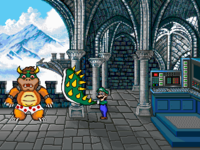
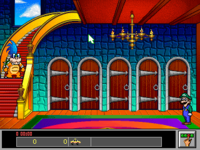
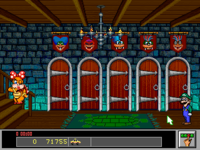
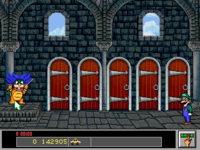


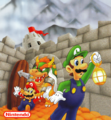
![Mario meeting Luigi in the PC version (scene by Dan Guerra[50])](https://mario.wiki.gallery/images/thumb/e/ef/Mario_is_Missing%21_Luigi_and_Mario_PC.jpg/120px-Mario_is_Missing%21_Luigi_and_Mario_PC.jpg)